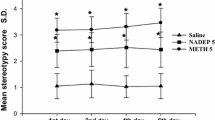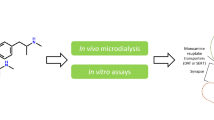Abstract
The formation of 6-hydroxydopamine (6-OHDA) from dopamine (DA) was investigated in the striatum of male Sprague-Dawley rats following a single administration of methamphetamine hydrochloride (100 mg/kg, sc). Rats were sacrificed 30, 60, and 90 min, and 1 wk after injection, and striatal 6-OHDA, DA, and 3,4-dihydroxyphenylacetic acid (DOPAC) were measured by HPLC with electrochemical detection. Methamphetamine decreased striatal DA and DOPAC levels (to 65 and 50% at 90 min, respectively) in the time-course study and also resulted in a long-lasting dopamine depletion (34%) 1 wk after its administration. However, endogenous 6-OHDA formation proved difficult to detect after administration of the methamphetamine alone. Pretreatment with the monoamine oxidase (MAO) inhibitor pargyline (100 mg/kg, ip) and the catechol-O-methyltransferase (COMT) inhibitor pyrogallol (25 mg/kg, ip) resulted in the HPLC detection of a 6-OHDA-like substance 30 min after methamphetamine administration when the oxidizing potential was set at 0.5 V, but not when it was set at 0.2 V. Moreover, pargyline (25 mg/kg, ip) alone or in combination with pyrogallol exacerbated the long-lasting dopamine depletion induced by methamphetamine (50 mg/kg, sc). These results indicate that simultaneous inhibition of MAO and COMT provides a cellular environment that encourages the autoxidation of dopamine to a 6-OHDA-like substance.
Similar content being viewed by others
References
Breese G. R. and Traylor T. (1971) Depletion of brain noradrenaline and dopamine by 6-hydroxydopamine.Br. J. Pharmacol.,42, 88–99.
Cohen G. and Heikkila R. E. (1974) The generation of hydrogen peroxide, superoxide radical and hydroxy radical by 6-hydroxy-dopamine, dialuric acid and related cytotoxic agents.J. Biol. Chem. 249, 2447–2452.
DeVito M. J. and Wagner G. C. (1989) Methamphetamine-induced neuronal damage: A possible role for free radicals.Neuropharmacology 28, 1145–1150.
Evans J. and Cohen G. (1993) Catecholamine uptake inhibitors elevate 6-hydroxy-dopamine in brain after administration of 6-hydroxydopa.Eur. J. Pharmacol. 232, 241–245.
Gibb J. W. and Kogan F. J. (1979) Influence of dopamine synthesis on methamphetamine-induced changes in striatal and adrenal tyrosine hydroxylase.Naunyn-Schmiedeberg’s Arch. Pharmacol. 310, 185–187.
Graham D. G. (1978) Oxidative pathways for cathecholamines in the genesis of neuromelanin and cytoxic quinones.Mol. Pharmacol. 14, 633–643.
Hedreen J. C. and Chalmers J. P., (1972) Neuronal degeneration in rat brain induced by 6-hydroxydopamine,Brain Res. 47, 1–36.
Karoum F., Chrapusta S. J., Egan M. F., and Wyatt R. J. (1993) Absence of 6-hydroxydopamine in the rat brian after treatment with stimulants and other dopaminergic agents: A mass fragmentographic study.J. Neurochem. 61, 1369–1375.
Kostrzewa R. M. and Jacobowitz D. M. (1972) The effect of 6-hydroxydopa on peripheral adrenergic neurons.J. Pharmacol. Exp. Ther. 183, 284–297.
Kostrzewa R. M. and Jacobowitz D. M. (1974) Pharmacological actions of 6-hydroxydopamine.Pharmacol. Rev. 26, 199–288.
Marek G. J., Vosmer G., and Seiden L. S. (1990) Pargyline increases 6-hydroxy-dopamine levels in the neostriatum of methamphetamine-treated rats.Pharmacol. Biochem. Behav. 36, 187–190.
Perumal A. S., Tordzro W. K., Katz M., Jackson-Lewis V., Cooper T. B., Fahn S. and Cadet L. (1989) Regional effects of 6-hydroxydopamine (6-OHDA) on free radical scavengers in rat brain.Brain Res. 504, 139–141.
Ricaurte G. A., Guillery R. W., Seiden L. S., Schuster C. R., and Moore R. Y. (1982) Dopamine nerve terminal degeneration produced by high doses of methylamphetamine in the rat brain.Brain Res. 235, 93–102.
Rollema H., De Vries J. B., Westerink B. H. C., Van Putten F. M. S., and Horn A. S. (1986) Failure to detect 6-hydroxydopamine in rat striatum after the dopamine releasing drugs dexamphetamine, methylamphetamine, and MPTP.Eur. J. Pharmacol. 132, 65–69.
Seiden L. S. and Vosmer G. (1984) Formation of 6-hydroxy-dopamine in caudate nucleus of the rat brain after a single large dose of methylamphetamine.Pharmacol. Biochem. Behav. 21, 29–31.
Slivka A., and Cohen G. (1985) Hydroxyl radical attack on dopamine.J. Biol. Chem. 260, 15466–15472.
Von Voigtlander P. F. and Losey E. G. (1978) 6-Hydroxydopa depletes both brain epinephrine and norepinephrine: interactions with antidepressants.Life Sci. 23, 147–150.
Wagner G. C., Seiden L. S., and Schuster C. R. (1979) Methamphetamine induced changes in brain catecholamines in rats and guinea pigs.Drug Alcohol Dep. 4, 435–438.
Wagner G. C., Ricaurte G. A., Seiden L. S., Schuster C. R., Miller R. J., and Westley J. (1980) Long-lasting depletions of striatal dopamine and loss of dopamine uptake sites following repeated administration of methamphetamineBrain Res.,181, 151–160.
Author information
Authors and Affiliations
Rights and permissions
About this article
Cite this article
Kita, T., Wagner, G.C., Philbert, M.A. et al. Effects of pargyline and pyrogallol on the methamphetamine-induced dopamine depletion. Molecular and Chemical Neuropathology 24, 31–41 (1995). https://doi.org/10.1007/BF03160110
Received:
Accepted:
Issue Date:
DOI: https://doi.org/10.1007/BF03160110




